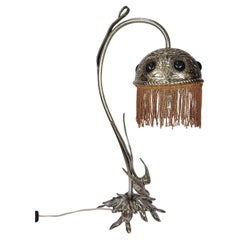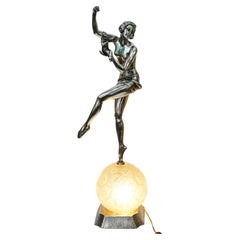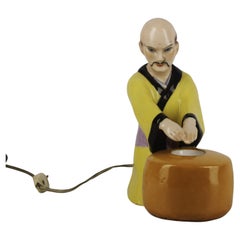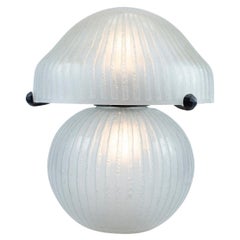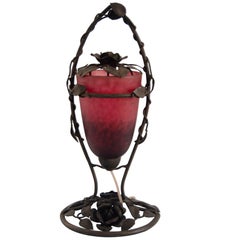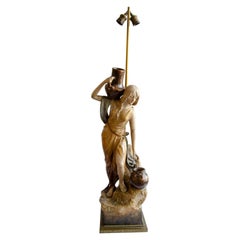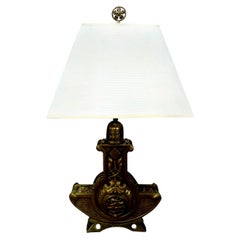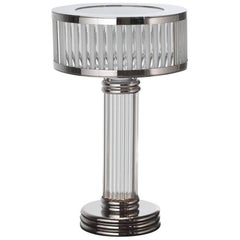Saint John Table Lamps
to
8
11
Height
to
Width
to
11
5
3
2
9
5
4
2
2
1
4
7
4
2
2
2
11
8
2
1
11
11
11
1
1
1
1
Art Nouveau Swallow Bird Table Lamp
Located in Buenos Aires, Argentina
Art Nouveau Swallow Bird Table Lamp
Origin: Austria
Circa 1910
Art Nouveau Style
120 W electrific
Electroplated bronze and red glass, jewels, and reli...
Category
Vintage 1910s Austrian Art Nouveau Table Lamps
Materials
Bronze
Lampara art déco Enrique Molins Balleste
By Enrique Molins-Balleste
Located in Buenos Aires, Argentina
Art deco lamp Enrique Molins Balleste
Art deco style table lamp
Artist Enrique Molins Balleste
Circa 1930 Origin France
materials electroplated...
Category
Vintage 1930s French Art Deco Table Lamps
Materials
Pewter
$1,360 Sale Price
20% Off
Chiparus Perfume Lamp Art Deco
By Demetre Chiparus
Located in Buenos Aires, Argentina
Chiparus perfume lamp Art Deco
ceramic Art Deco night lamp
Hand painted, excellent condition
signed Chiparus and stamped on its base Etling
Origin Paris circa 1930
Demetre Haralamb Chiparus (September 16, 1886, Dorohoi, Romania - January 22, 1947, Paris, France) was a sculptor of the Art Deco period. He lived and worked in Paris.
We are Saint John, a company dedicated to the trade...
Category
Vintage 1930s French Art Deco Table Lamps
Materials
Ceramic
Daum Nancy Lamp
By Daum
Located in Buenos Aires, Argentina
Daum Nancy lamp
Art Deco period
Origin France Circa 1930
Etched glass, wrought iron
Incised and signed on screen and base
with Daum Nancy and the cross...
Category
Vintage 1930s French Art Deco Table Lamps
Materials
Wrought Iron
$10,200
Table Lamp in Iron and Glass Schneider France
By Charles Schneider
Located in Buenos Aires, Argentina
Table lamp in iron and glass ((SCHNEIDER))
France, circa 1910
very good condition
Art Nouveau red glass signed on the glass.
Charles Schneider was an Art Deco glass artist, born in E...
Category
Vintage 1910s French Art Nouveau Table Lamps
Materials
Iron
$1,200 Sale Price
20% Off
Terracotta Art Nouveau Lamp
By Goldscheider Manufactory of Vienna
Located in Buenos Aires, Argentina
Terracotta Art Nouveau lamp
Origin Austria facade 1904
attributed Goldscheider signature illegible
illuminated in the upper part and in the lowe...
Category
Antique Early 1900s Austrian Art Nouveau Table Lamps
Materials
Terracotta
$1,760 Sale Price
20% Off
Art Deco Lamp Glass 'Perruches' Carrillo
Located in Buenos Aires, Argentina
Art Deco lamp glass (perruches) Carrillo
Artist Carrillo origin France
circa 1930 perfect condition
electrified 220 w
formed and sealed.
Category
Vintage 1930s French Art Deco Table Lamps
Materials
Art Glass
$480 Sale Price
4% Off
Napoleon III Table Lamp
Located in Buenos Aires, Argentina
Napoleon III table lamp
materials gilt bronze, onyx and cloisone enamel
Origin France circa 1860
electrified 220 w perfect condition.
The Napoleon III style had its heyday during the...
Category
Antique 1860s French Napoleon III Table Lamps
Materials
Enamel
$1,200 Sale Price
20% Off
Pair of Napoleon III Lamps marble and enamel
Located in Buenos Aires, Argentina
Pair of Napoleon III lamps
Origin France 19th century, circa 1860
electrified 220 w perfect condition
gilt bronze, onyx and cloisonné enamel
39 cm high up to the screen frame.
The Na...
Category
Antique 1860s French Napoleon III Table Lamps
Materials
Enamel
$5,440 Sale Price
20% Off
Art Deco Illuminated Bear Sculpture
Located in Buenos Aires, Argentina
Art Deco illuminated bear sculpture
pair of bears on the ice
origin Italy, circa 1920
electrified 220 w
perfect condition.
Category
Vintage 1920s Italian Art Deco Table Lamps
Materials
Alabaster
$2,312 Sale Price
20% Off
Napoleon III Table Lamp Enamel
Located in Buenos Aires, Argentina
Napoleon III table lamp
onix base, enamel champlevé,
circa 1900 origin France electrified 220 w
perfect condition.
The Napoleon III style had its heyday during the 1850s and 1880s. E...
Category
Antique Early 1900s French Napoleon III Table Lamps
Materials
Bronze
$1,120 Sale Price
20% Off
Related Items
Austrian Art Nouveau Bronze Lamp
Located in Houston, TX
Lovely period Austrian Art Nouveau bronze table lamp. This beautifully detailed, high quality Austrian bronze lamp has been newly wired and would w...
Category
Vintage 1910s Austrian Art Nouveau Table Lamps
Materials
Bronze
Art Deco Table Lamp
By Sofar
Located in Rebais, FR
Art Deco table lamp with nickel finish and glass rods.
Category
21st Century and Contemporary French Art Deco Table Lamps
Materials
Brass
Art Deco Lamp
By Sofar
Located in Rebais, FR
Art Deco lamp with led in the foot.
Category
21st Century and Contemporary French Art Deco Table Lamps
Materials
Brass
Art Nouveau lamp circa 1910
Located in NANTES, FR
Beautiful Art Nouveau lamp, circa 1910.
Brown-veined alabaster shell.
The base is bronze with floral decoration.
Electric and in perfect condition.
Total Height: 52 cm
Shell Diamete...
Category
Vintage 1910s French Art Nouveau Table Lamps
Materials
Alabaster, Bronze
Schneider and A. Moyens Art Deco Lamp
By Charles Schneider
Located in NANTES, FR
Art Deco lamp circa 1925.
Wrought iron base with gingko biloba decoration stamped A. Moyens (Marseille ironworker).
Glass paste tulip signed Schneider.
In perfect condition and elect...
Category
Vintage 1920s French Art Deco Table Lamps
Materials
Wrought Iron
Art Deco Table Lamp
By Sofar
Located in Rebais, FR
Art Deco table lamp with nickel finish and glass rods.
Category
21st Century and Contemporary French Art Deco Table Lamps
Materials
Brass
Art Nouveau Table Lamp, 1910's
Located in Praha, CZ
Beautiful antique Art Nouveau lamp made of copper alloy, patinated to old bronze. Produced in former Czechoslovakia in the very beginning of 2...
Category
Early 20th Century Czech Art Nouveau Table Lamps
Materials
Metal
Daum Nancy Art Nouveau Table Lamp
By Daum
Located in Dallas, TX
Daum Cameo Glass and Wrought Iron Maple Leaf Table Lamp, circa 1920 Art Nouveau Art Deco design.
Mottled and variegated glass base with with carve...
Category
Vintage 1920s French Art Deco Table Lamps
Materials
Art Glass
Art Nouveau Slag Glass Table Lamp
Located in Peekskill, NY
This is a nice sized lamp with a 17 inch diameter. The base is heavy bronze with with beautiful clean lines. The shade and slag glass are free of cracks or chips. Each glass panel ha...
Category
Early 20th Century American Art Nouveau Table Lamps
Materials
Bronze
Offrande Art Deco Table Lamp with Kneeling Nudes Fayral & Daum Nancy, Le Faguays
By Pierre Le Faguays, Daum, Max Le Verrier
Located in Antwerp, BE
Offrande Art Deco table lamp with kneeling nudes holding a Daum glass shade signed Fayral, pseudonym of Pierre Le Faguays & Daum Nancy France.
Execu...
Category
Vintage 1920s French Table Lamps
Materials
Marble, Metal
$12,234
H 12.8 in W 20.08 in D 4.73 in
Majorelle Art Nouveau Lamp
By Atelier Majorelle
Located in NANTES, FR
Majorelle Art Nouveau lamp
Large lamp around 1900 foot in gilded bronze and lampshade in alabaster.
Very good quality of bronze and pretty floral m...
Category
Early 20th Century French Art Nouveau Table Lamps
Materials
Alabaster, Bronze
Art Deco Table Lamp
By Jacques le Chevalier and René Koechlin 1
Located in Saint-Ouen, FR
Art Deco table lamp glass and bronze base.
Category
Mid-20th Century French Art Deco Table Lamps
Materials
Bronze
